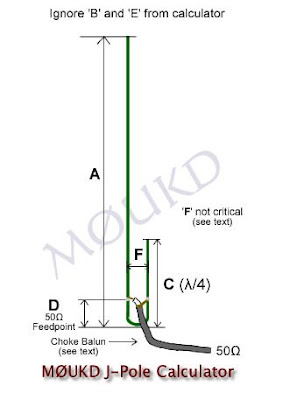I constructed this antenna a few years ago. It is an inexpensive antenna that is easy to construct. In about one and a half hours time, and less than R100 worth of materials, you can have a great performing omnidirectional J-Pole antenna. This antenna is based on the same idea as the 2 Meter J-Pole Calculator available HERE. The J-Pole antenna is basically an end fed half wave dipole that uses a 1/4 wave shorted matching stub as an impedance transformer. The J-Pole antenna will yield slightly less than 3 DB of omnidirectional gain.
The material I chose to build the j-pole antenna was 15 + 20 mm copper pipe and a few other fittings used for plumbing. (View the images below for more detail) Here are the plans:
(Click images for larger view.)
I cannot remember which measurements I used many years ago to build this antenna and which frequency was used for resonance. At the time of construction I did not have an antenna analyzer and the only measuring "tool" was an SWR Meter. I now have a Nano VNA and I decided to revisit this antenna. I made a modification to the original antenna. More in this later.
(Click images for larger view.)
The NanoVNA reflected a 1:1 SWR but the antenna resonated on 411.000 Mhz. On 433.000 Mhz the SWR was 1:2 - 1:3 and the impedance more than 50 Ohm. The antenna was usable like I constructed it but I want to modify it to see if I can move the frequency to 433.550 Mhz with a 1 : 1 SWR. I decided to use a piece of soldering wire (30mm) that I added to the 1/4 wave shorted matching stub. I moved the connection points and BNC connector 20mm upwards. Spot-on the antenna now resonates at 433.500 Mhz with and SWR of 1:1 and the impedance is 50.9 Ohm. Now that I know that the matching stub must be extended I needed an easy modification. Well I came up with the modification as shown in the images below.
(Click images for larger view.)
What does the SWR and Power output look like on the SWR Meter after the modification. Here are two images and I would say that the two measuring instruments compare fairly well.
(Click images for larger view.)
Finally: This antenna will be used for the ZS1I SVXLink Reflector UHF Radio and will be installed permanently this coming week. Although I originally tuned the antenna with a UHF Radio and SWR Meter I must confess that an antenna analyzer is a must have instrument if you want to construct and play around with antennas. It provides you with so much more information that an SWR Meter.














